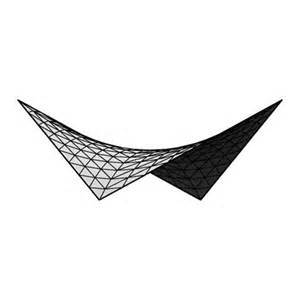Skew Quads
 P
,
Q
,
R
,
and
S
are four coplaner points that lie on the sides
A
B
,
B
C
,
C
D
,
and
D
A
,
respectively, of a skew quadrilateral. Then what is
∣
P
B
∣
∣
A
P
∣
⋅
∣
Q
C
∣
∣
B
Q
∣
⋅
∣
R
D
∣
∣
C
R
∣
⋅
∣
S
A
∣
∣
D
S
∣
?
P
,
Q
,
R
,
and
S
are four coplaner points that lie on the sides
A
B
,
B
C
,
C
D
,
and
D
A
,
respectively, of a skew quadrilateral. Then what is
∣
P
B
∣
∣
A
P
∣
⋅
∣
Q
C
∣
∣
B
Q
∣
⋅
∣
R
D
∣
∣
C
R
∣
⋅
∣
S
A
∣
∣
D
S
∣
?
The answer is 1.
This section requires Javascript.
You are seeing this because something didn't load right. We suggest you, (a) try
refreshing the page, (b) enabling javascript if it is disabled on your browser and,
finally, (c)
loading the
non-javascript version of this page
. We're sorry about the hassle.
4 solutions
I think you're probably the only person to solve like this. :D
Good job though!
:P Just draw perpendiculars from each point of the skewed quadrilateral to the plane, then the ratios in question are transformed into ratios of heights, which, will multiply one by succesive cancellation.
The easiest solution for the placement of P, Q, R, and S is the midpoint of the 4 sides. Thus each fraction equals 1, producing a final answer of 1 .
For the points to be coplanar, the line between one pair would have to be parallel to the line between the other pair. Say we decide to put P and Q together as a pair. There would have to be a horizontal line connecting P and Q, meaning that PB=BQ. Therefore, AP=QC. This means that when we multiply the 2 fractions at the beginning of the equation, both sides cancel out to get 1. Same logic applies for the other 2 fractions/points, and then you get 1*1=1. So 1 is the answer!
We can rewrite our expression as S A A P ⋅ P B B Q ⋅ Q C C R ⋅ R D D S .
Then, we use the law of sines in triangles A P S , B Q P , C R Q , D S R , that says that, particularly in triangle A P S , sin ∠ A S P A P = sin ∠ S P A S A We then use that to write S A A P = sin ∠ S P A sin ∠ A S P .
Using this in all the triangles mentioned before, our expression is now sin ∠ S P A sin ∠ A S P ⋅ sin ∠ P Q B sin ∠ B P Q ⋅ sin ∠ Q R C sin ∠ C Q R ⋅ sin ∠ R S D sin ∠ D R S
Now, we rearrange once again to obtain sin ∠ R S D sin ∠ A S P ⋅ sin ∠ S P A sin ∠ B P Q ⋅ sin ∠ P Q B sin ∠ C Q R ⋅ sin ∠ Q R C sin ∠ D R S Since P , Q , R and S are coplanar, the angles mentioned are the angles formed by each side of the quadrilateral A B C D and the plane P Q R S . This means that, as a particular example, ∠ A S P = ∠ R S D (this is because the angle formed by a line L not in a plane π and the plane is the same as the one between L and every line in π ; so the angle formed by A S and S P is congruent to the one between A S and R S ). This means that sin ∠ R S D sin ∠ A S P = 1 , and if used with every pair of angles, it makes sin ∠ R S D sin ∠ A S P ⋅ sin ∠ S P A sin ∠ B P Q ⋅ sin ∠ P Q B sin ∠ C Q R ⋅ sin ∠ Q R C sin ∠ D R S = 1 Thus, P B A P ⋅ Q C B Q ⋅ R D C R ⋅ S A D S = 1